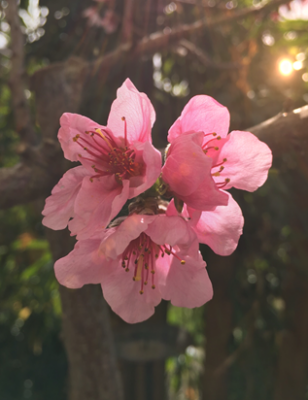
One of the exciting things that happens this month in my greenhouse is the blossoming of the nectarine. It always feels too early, blossoming while it feels so wintery out there, and is one of the first bits of blossom in my garden. It is a wonderful harbinger of spring.
My ‘tree’ is actually a dwarf nectarine in a pot, which is how it lives in the greenhouse. There are several reasons why I moved it in there. The first and most pressing at this moment in the year is the dastardly peach leaf curl. This is a fungal disease that is carried by late winter rains – yes that’s any rain that is falling right now. The fungal spores alight on the peach or nectarine just as the young leaves are budding. As they emerge the fungus causes them to turn shades of red and orange, and look blistered and twisted, instead of the sweet green little shoots you would expect. This doesn’t kill the tree as such, but it weakens it, preventing it from photosynthesising and making use of the spring sunlight falling on it. A plant infected with peach leaf curl will gradually decline and stop producing blossom and fruit, and eventually may even die. It has a very simple solution though: keep the late winter rains off of the leaves. It’s really as straightforward as that. Pop the tree inside the greenhouse where it is entirely protected from rain and the problem just doesn’t occur. If your peach or nectarine tree is too big to move or is planted in the ground, you can mimic this by covering it at this time of year. A sheet of clear polythene will do the job, but of course you can rig up something more durable (and possibly more effective). But as long as it keeps the rain off until well into the spring, the plant will avoid this fate.
The other reason of course is because of the warmth and shelter that even an unheated greenhouse is able to provide. Nectarines and peaches are fairly hardy, but with blossom so early it is very likely to coincide with a frost, and any blossom that is hit by frost will not go on to produce a fruit. Again if you have a tree outside the protection from the polythene or plastic may be enough to stop the blossom from being frosted, or you can throw a piece of horticultural fleece over the plant.
Once the blossom is fertilised the plant needs warmth and sunshine in order to develop those beautiful, sweet and juice-filled fruits. The wild ancestors of peaches and nectarines do not grow at our latitude, and although there are some varieties that will do really well in a good UK summer, even they will need to be growing in your sunniest, most sheltered spot in order to produce the best fruit. Mine is the greenhouse, so why not use it?
The one drawback to growing in a pot as I am is that any fruit tree is a hungry plant – they need lots of water and food in order to produce all of those fruits, and root conditions in a pot can be non ideal. So it is really important at this time of year to look at whether your large potted plants need potting up into slightly larger pots, and they should at the very least have the top layer of compost scraped off and replaced with fresh compost. If this is followed by lots of feeding and watering through the growing year in a lovely sheltered greenhouse the tree should produce lots of beautiful nectarines.










